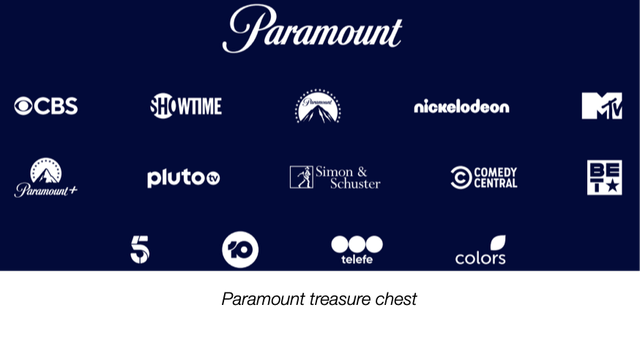Intro
Paramount Global (NASDAQ:PARA) is a free cash flow generative business that owns some of America’s favourite TV Media brands, Paramount film studios, and an impressive back catalogue of content. Unfortunately, the traditional product distribution channels are losing their popularity and PARA is facing new competitors and losing market share.
paramount.com
The Company is trying to adapt to the new business environment and is investing heavily to maintain its position in the new market. The company’s equity value is currently about $10bn and in FY2022, their declining TV Media business generated $5.5bn of profits and their growing Direct-To-Consumer division incurred $1.8bn of losses due to exclusive content and distribution investments.
Most of the analysts covering the stock tend to value Paramount by applying earnings multiple on consolidated earnings of the declining and growing businesses. This is a fundamentally wrong approach as it assumes that the fastest-growing part of the business has a negative value. In our opinion, a sum of the parts valuation is called for in the case of Paramount. In this article, we will assess the value of separate units of Paramount.
When applying a sum-of-the-parts valuation an assessment of the company’s corporate governance practices becomes essential. A discount to the sum has to be applied as shareholders cannot enforce immediate liquidation and the size of the discount depends on the level of management alignment with shareholders. We will see how Paramount ranks in this regard.
The gushers of cash from TV Media
TV Media is the largest division of Paramount. They produce and package content for broadcast and cable TV channels. The business has a strong position in the traditional media space and generates strong profits and does not require capital investment, it is a true free cash flow machine.
This division is troubled by concerns about declining linear TV viewership and declining allocation of advertising budgets to linear TV. Paramount has so far managed to stem the decline in viewership through higher pricing, but sooner or later the profits of the business will start declining as viewers leave. We see this as a declining business, but just like a gusher of oil produces a lot of value before the well runs dry, the TV Media business can also produce a lot of value before it fades to black. Declining media assets usually fetch about 5-7X pre-tax cash in the public market. Valuing TV Media at the lower bound would give a value in excess of $28bn.
|
Company |
EBITDA FY2022 |
EV/EBITDA |
|
Nextar |
2000 |
6.4X |
|
Tegna |
1100 |
5.6X |
|
ITV plc |
680 |
5.5X |
|
Lee Enterprises |
100 |
5.7X |
|
Gannett |
290 |
5.3X |
TIKR.com data
Paramount’s value is actually much larger than the TV Media cash gusher alone. The company has been a leading player in the TV and film industry for decades and accumulated an impressive library of movies, series, and TV shows. They own approximately 4,100 film titles including Titanic, Braveheart, Forrest Gump, The Godfather, and a number of successful franchises such as Mission: Impossible, Transformers, Star Trek and Paranormal Activity. The company’s library is also stocked with more than 140,000 TV episodes. This back catalogue of older content can be licensed out for a fee with practically no added expenses. It is a very valuable asset.
Paramount has also been pouring billions into its DTC business called Paramount+. The streaming platform now has close to 60m paying subscribers and an exclusive content library of movies and series. This business has significant value. Paramount also owns Simon & Schuster, a publisher that it intends to sell for about $2bn.
Overall, it is easy to see that the value of PARA is much greater than the current Enterprise Value of the business of $25.5bn.
How much is their back catalogue worth?
The streaming revolution did steal viewers away from traditional TV channels but it has also created a lucrative way for content owners to monetise their back catalogues of old movies and TV series and shows. The value of these media rights has been soaring in the market, especially after Covid when viewers started signing up for streaming platforms in large numbers. The price of streaming licences for popular oldies such as Friends (WBD) or Seinfeld (SONY) has doubled, and the licensing revenues at Filmed Entertainment increased c60% over the last five years.
paramount.com
Back catalogue licensing revenues are generated not only by Filmed Entertainment but also by the TV Media business, rights to Star Trek, for example, are owned by CBS. Overall, Paramount generated $6.5bn in licensing revenues in the last financial year, which is made up of revenues from new production as well as old titles. Back catalogue licensing revenues are not disclosed separately so we can only make an approximate guesstimate of their value. We also have to keep in mind that PARA has been recently pulling older content from competing streaming platforms thus impairing its licensing revenues.
To get a sense of what Paramount catalogue could be worth we can look at some recent transactions in the market. We are quite fortunate in this regard because an asset, really similar to Paramount Pictures has recently changed hands. In 2022 Amazon paid $8.5bn for MGM Studios, which owns more than 4,000 films and 17,000 TV shows. This library is similar in size to Paramount Pictures and the value should be similar. On top of this, Paramount also owns all the valuable titles from CBS, such as Star Trek. We, therefore, believe that the value of the content library of Paramount is in excess of $8.5bn.
How much is Paramount+ worth?
Paramount+ is the company’s main streaming platform, it now has about 60 million subscribers and is likely to generate in excess of $6bn in revenues in 2023. Paramount+, just like its competitors, is pouring billions of dollars to create an exclusive-to-streaming content library.
Unfortunately, the division is currently loss-making and therefore more difficult to value, therefore we use a number of other growing content distribution platforms for comparison. We have noticed that platforms of scale owning a significant share of their content and having a more sticky subscriber base tend to command higher valuation multiples.
|
EV/Sales |
Customer stickiness |
|
|
Netflix |
5X |
High |
|
New York Times |
2.3X |
Above average |
|
Spotify |
2.2X |
Above average |
|
Curiosity Stream |
0.8X (P/S) |
Below average (?) |
Tikr.com data
Paramount+ owns some exclusive content within the division but mainly sells back catalogues from other parts of the Group. They are a platform of considerable scale, but they are not among the top 3-4 leaders. Paramount+ does not disclose customer churn, but it is quite easy for their customers to switch, we therefore assume a below-average customer stickiness.
Paramount+ should sit somewhere between CuriousityStream and Spotify in terms of valuation multiples applied, therefore, we value them at 1-1.5X sales. On that basis, Paramount+ should be worth in excess of $6bn and possibly as high as $9bn.
The value of this business will most likely continue increasing as Paramount will most likely continue investing heavily and attracting new customers. The problem is that the company might not get a good return on its investment. Last year Paramount+ invested roughly $4bn in streaming content and plans to invest as much as $12bn over the next two years. We really doubt that they can create one dollar of value for every dollar of investment especially when all the other competitors are also investing heavily. In two years’ time, the value of Paramount+ will be greater but most likely not by more than double.
Corporate governance considerations
So far we have discovered about $44bn of value across all divisions of Paramount, which is significantly greater than the current Enterprise Value of $25.5bn. As mentioned in the intro, adding the value of the separate parts is not enough, we also need to evaluate the corporate governance of the business as we have no direct control over the assets.
Controlling shareholders can estimate value by adding asset values or discounting the free cash flows, whereas minority holders should stick with discounting dividends. The distinction between the two is often blurred. If a business’s corporate governance practices are top-notch, especially if the business is run by managers aligned with common shareholders, then even the minority holders can add up discounted free cash flows in estimating value. Berkshire Hathaway (BRK.A) (BRK.B), for example, pays no dividend and has no plans to start paying in the near future but its value is not zero as shareholders have trust in Mr Buffett to reinvest the free cash with shareholders’ best interests in mind. The less trust we have in the judgement or integrity of the management the bigger discount to free cash flow valuation we should apply.
A common theme in valuing declining businesses is the unwillingness of managers to throw in the towel and carry out an orderly run-down. There is not much social prestige in presiding over a business in decline, so most managers try to protect their domain by making acquisitions or entering some high-growth lines of business that add numbers to the business’s top line but not necessarily to shareholders’ bottom line. Accounting tricks sometimes also surface, all in the name of trying to stave off potential acquirers who usually don’t intend to stick with the existing c-suite. Sometimes the motivation can be different, for example, protecting the family legacy or maintaining a position in the high society.
Why is it selling for less than the sum of the parts?
Shari Redstone controls close to 80% of the voting shares of Paramount, through National Amusement. No change in strategic direction or acquisition can be approved without her consent. Ms Redstone has taken over the business that her father has created, and as we understand, is keen to make her mark, prove herself and possibly extend the family legacy. We, therefore, believe that the controlling shareholders’ interests might be misaligned with minority shareholders and a discount on the sum of parts is called for.
paramount.com
Our estimated Sum-Of-The-Parts of Paramount is c44bn, subtracting debt we obtain an equity valuation of $28bn, versus the current market cap of $10bn. Part of the discount to the value stems from the corporate governance issues just described, but even after applying the common 30-40% “lack-of-control” discount the stock still looks cheap. We need to get to the root of this.
|
Value (billion) |
|
|
TV Media |
28 |
|
Content back catalogue |
8.5 |
|
Paramount+ |
6 |
|
Simon & Schuster |
2 |
|
Overall enterprise value |
44.5 |
|
Debt |
16 |
|
Equity Value |
28.5 |
|
Discount for lack of control |
35% |
|
Value for minority holders |
18.5 |
Summary of my own value estimates
The market must be assuming that the current management is not acting in the best interest of shareholders when they are making capital allocation decisions. Basically, it is assumed that the enormous amounts spent on the streaming business are creating little value.
We are also of the opinion that Paramount+ will find it very difficult to survive on its own. It is only the 5-6th largest streaming platform and is having to compete in a difficult market with low switching costs against larger players. In markets like this, it’s usually the biggest players who win as they are able to leverage their content and technology spending over the largest number of customers and thus offer the best value for money.
We believe, Paramount+, on itself, will not reach the top 3 position among streaming platforms which would ensure its independence and we do not think that the platform itself is worth as much as the company has put into it. In our opinion, Paramount would be worth a lot more if it would just licence its content catalogue to other leading platforms or indeed just merge with one of them.
How it will likely to play out over the next few years?
Shari Redstone is unlikely to let go of PARA just a few years after a long-fought battle to merge CBS and Viacom. We believe that she wants to make her market and is unlikely to sell as long as Paramount+ subscriber numbers are growing.
Most likely Paramount will continue pouring money into their DTC business using declining profits from their TV Media division. In the streaming segment, PARA is competing against much larger players, and over the longer term, the economies of scale will prevail and eventually Ms Redstone will have to give up and consider acquisition bids in our view. In our opinion, the longer Paramount stays independent the more value will be lost.
We believe Apple (AAPL), Warner Bros. Discovery, Sony, or Lions Gate (LGF.A) (LGF.B) to be the most likely suitors/peers. Paramount+ might not have much value to larger acquirers with their own platforms if they already have Paramount+ subscribers as their customers (Netflix (NFLX), Amazon (AMZN), Disney (DIS)). Ownership of Broadcast TV assets might prevent other groups in the broadcast TV business (Comcast, Disney) from making bets.
The recent dividend cut makes the prospect of acquisition more distant as the share price drifted even further away from fair value and the controlling shareholder has stated previously that they would consider only fair price bids. As we understand buybacks are not planned for the time being.
Given that the company is investing $4-6bn per annum into DTC and assuming that they are only getting 30 cents of value per dollar invested, we could guesstimate that the DTC business only creates $1-2bn of added value per annum. Assuming that the profits in the TV Media division will decline by 10% per annum on average, $3bn of value would be lost here per annum. Adding the two together it seems likely that Paramount would burn about $1-2bn of value per annum by staying independent. This is a really conservative guesstimate, but given the level of uncertainty, we believe this level of conservatism is called for.
In the downside scenario, over the next 3 years, the Enterprise Value of Paramount would decline to about $38bn and equity value to about $22bn. Deducting the discount for lack of control, from the minority shareholders’ perspective the equity would be worth only $14-15bn in 3 years. The longer the business stays independent and continues pouring money into a division with a poor competitive position instead of paying dividends, the lower return on investment shareholders will incur.
Is it an attractive investment?
In our opinion, Paramount stock is definitely cheap, but it also has issues. They have a really profitable but declining legacy TV Media business, but not paying any dividends out of it. Instead, they are pouring money into a business with a poor competitive position at a time when everyone else is also doing it and common shareholders have no way of stopping that. Time is not on the shareholders’ side with this one, on the other hand, it does trade at a significant discount to the sum of parts and a potential acquisition price. We see PARA stock as a merger arbitrage bet where the probability of loss is negligible but the upside potential is unclear.
Risk factors of this thesis
- The time it takes to start considering acquisition/merger bids.
- TV Media business decline could accelerate and profits might fall faster than revenues due to fixed costs of the business. The Cable TV business is probably more at risk than Broadcast TV.
- Back catalogue value might be impaired by the avalanche of new content that will be brought to market over the next 2-3 years as streaming wars are ongoing.
- The political situation in the U.S. might complicate any deal-making.
Read the full article here











